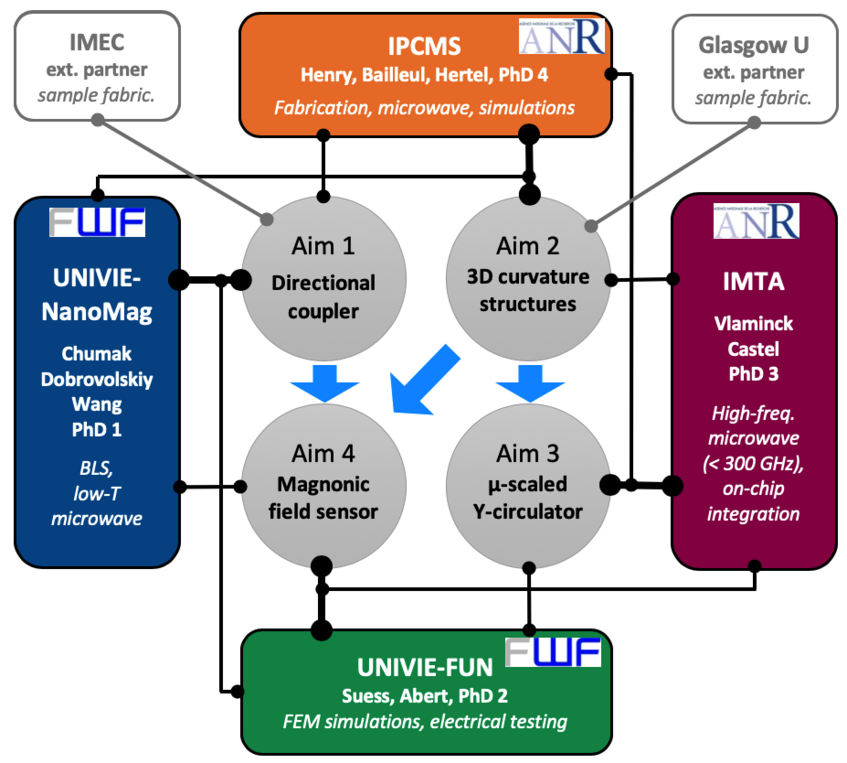Non-reciprocal 3D architectures for magnonic functionalities (FWF “MagFunc")
FWF project I 4917-N “Non-reciprocal 3D architectures for magnonic functionalities”.
01.10.2020 – 30.09.2024
Principal Investigator: Univ.-Prof. Dr. Andrii Chumak
Scientific Project Staff: Fabian Majcen (master’s student), Noura Zenbaa (PhD student), Andrey Voronov (PhD student), Dr. Sebastian Knauer (senior postdoc)
Partners:
Physics of Functional Materials, Faculty of Physics, University of Vienna
Team: Prof. Dr. Dieter Suess, PD Dr. Claas Abert
Institut Mines-Télécom Atlantique, Brest, France
Team: Prof. Dr. Vincent Vlaminck, Dr. Vincent Castel
Institut de Physique et Chimie des Matériaux de Strasbourg, France
Team: Dr. Yves Henry, Dr. Matthieu Bailleul, Dr. Ricardo Hertel

Our project, Non-Reciprocal 3D Architectures for Magnonic Functionalities, focuses specifically on the investigation of novel non-reciprocal magnon phenomena in 2D and 3D hybrid architectures at the nanoscale and contributes directly to the development of non-reciprocal microwave devices and sensors.
Non-reciprocal microwave components such as circulators, isolators, and phase shifters, are invaluable tools in both today’s communication systems and future quantum computers. Their ability to inhibit signal flow in one direction while allowing it in the reverse direction plays a crucial role in either protecting microwave devices from reflections, isolating the transmitter from the receiver in radar architecture, or shielding qubits from their environment. These non-reciprocal functionalities rely almost entirely on the gyrotropic nature of the magnetization dynamics. However, the current magnetic field-based components in-use tend to be relatively large, off-chip, limited in number, and costly to assemble. These issues have recently triggered intensive efforts from various fields of research to develop miniaturized non-reciprocal technologies compatible with used in modern devices integrated circuit technology.
Among all the potential solutions for this challenge, the emerging field of magnonics, which focuses on the implementation of elementary magnetic excitations called spin waves and their quanta magnons for unconventional electronic applications, is well engaged in the hunt with several recent demonstrations of non-reciprocal properties. Furthermore, magnonics is a fast-growing field with promising potentialities for novel computing and data processing approaches, improved power consumption performances, and the downscaling of broadband microwave analog devices with feature-size designs below 100 nanometers integrable in ICT.
In order to advance in this exciting direction, we plan to employ a complete and multidisciplinary approach encompassing finite element micromagnetic simulations combined with analytical models to find architectures with the targeted phenomena. These architectures will allow us to develop the aforementioned non-reciprocal microwave devices and sensors. These will be fabricated using state of the art nano-patterning methods in a clean room environment and will be measured via different complementary experimental techniques such as optical spectroscopy and propagating spin-wave spectroscopy at room and low temperatures.
The four Partner Teams of researchers gathered around this Austrian-French collaborative project constitute a rich panel of complementary skills with proven track records of excellent scientific research. The French Teams are led by Vincent Vlaminck (coordinator from the ANR side) from the Institut Mines Télécom- Atlantique and by Yves Henry from the Institut de Physique et Chimie des Matériaux de Strasbourg. The Austrian Teams are represented by Andrii Chumak (coordinator from the FWF side) and by Dieter Suess, each leading separate research groups at the University of Vienna.
